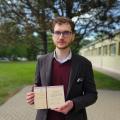Paieška
2024. 05. 03
-
FTMC PhD student P. Rivera on the chemistry of the future: we need to stop and rethink how to work more sustainably
On 23-26 April, the international student conference Open Readings 2024 was organised by Vilnius University and FTMC. Here, young scientists presented their research, listened to invited guests - world-renowned experts - and took part in discussions.
One of them, held on 24 April, was entitled "Green Chemistry: Towards Sustainable Future". Participants included US chemists Prof. Dr. Makeda Tekle-Smith (Columbia University) and Dr. Andrew Pun (University of California San Diego), and Pamela Rivera, a PhD student in the FTMC Department of Nanoengineering.
It is pointed out that chemistry and other related fields are usually perceived as intimidating and hazardous subjects by the general public. However, the scientific community is working to change this perception and is increasingly talking about sustainable research.

(From left: Dr. Makeda Tekle-Smith, Dr. Andrew Pun, Pamela Rivera and Lukas Naimovičius. Screenshot of a video on the Open Readings Facebook page)
"Climate change is pressing in today's society. Not only chemists but professionals from every field of specialization should walk towards making their activities more sustainable. Of course, this is particularly special for chemists since our everyday work involves handling hazardous substances that people in other spheres of knowledge do not have access to.
Sometimes people are laser-focused and can not see beyond their eyes, especially when they are under stress or constrained anyhow. We could always take a step back, assess our workflows, and identify opportunities for recycling, reduction of harmful waste, and saving energy," says Pamela, who took part in the discussion.
On the other hand, she herself has faced unfounded stereotypes: "I worked some time in food manufacturing, and people generally have a bad perception of food additives, even when they are just synthetic forms of natural minerals and vitamins that they normally consume."

(Pamela Rivera. Photo: Hernandez & Sorokina / FTMC)
The young scientist from Peru now is developing electrochemical sensors based on laser-induced graphene (LIG) for the continuous monitoring of Zn content in plants. These sensors would later be applied to monitor the efficiency of fertilization programs.
How does this work contribute to the development of green chemistry?
"Currently, I am working with electroanalysis. This field is a great promise for green analytical chemistry since it enables accurate chemical analysis from small sample sizes and without the need for intensive sample preparation, additionally, it allows for in situ analysis and implies less energy-intensive analytical procedures.
The magic of electroanalysis in comparison to other branches of analytical chemistry is that our everyday tool is a simple potentiostat that is relatively low in energy consumption if you compare it to other techniques such as vibrational spectroscopy, chromatography, or mass spectroscopy, just to mention a few. Yet we aim at developing methods that can achieve comparable sensitivities and accuracy," says FTMC chemist.
Watch the Open Readings discussion "Green Chemistry: Towards Sustainable Future" on the Open Readings Facebook account by clicking here (from 1:36:27).
FTMC and Open Readings information
Susiję:

2024. 12. 10
-
“Open Readings 2025” presents its first invited speakers
Prof. R. F. Jazzar has been recognised for excellence in organic chemistry, and Prof. Z. Molnár is one of the leaders in neuroscience.
-cccb647d67741b36c899c3c05cca6fbd.png)
2024. 09. 13
-
A. Nacys, a chemist developing alternative energy sources, receives a PhD
This work is about the development of new materials and their potential applications in fuel cells.

2024. 06. 10
-
A great opportunity for pupils, students and researchers: why apply to the Baltic-American Freedom Foundation?
After spending a year in the USA, Dr. Arūnas Stirkė brought microalgae science to the FTMC.

